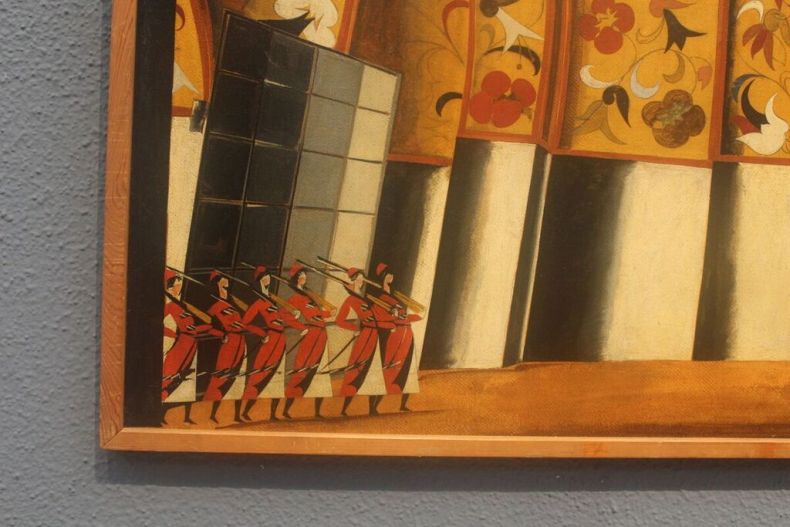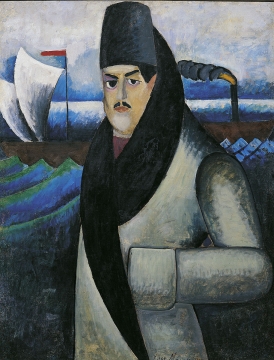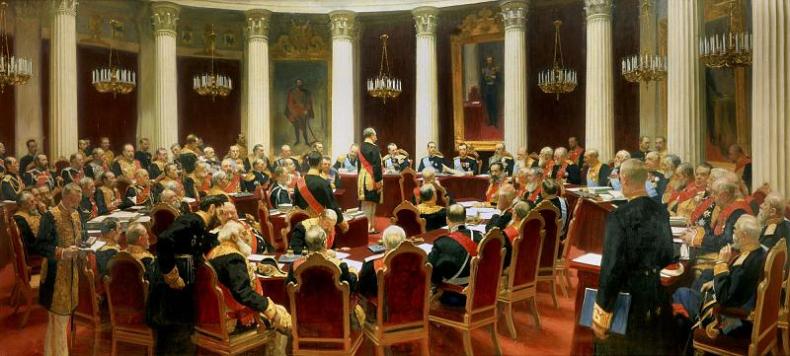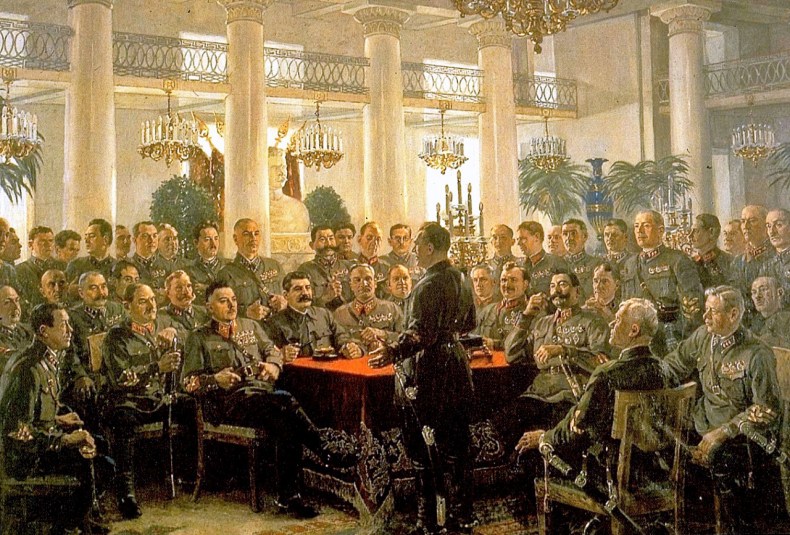In today’s luxury-loving, security-heavy Moscow, the contemporary art scene is growing fast. But as ever with art, the story is complicated. For all the new money in Moscow, low oil prices have hit the Russian economy hard and the country’s politics remain notoriously opaque. So what should art’s response be? Should he who pays the piper call the tune? Or should art speak truth to power? In Moscow, art, characteristically, is doing both.
In a moment of apt symbolism, 2015 saw Dasha Zhukova reopen Garage (the cultural institute she established in 2008) in a former-Soviet restaurant reconfigured by Rem Koolhaas. Now, Leonid Mikhelson, Russia’s richest man and founder of the V-A-C Foundation, has enlisted Renzo Piano to create a major new cultural venue out of an old, tsarist-era power plant on the banks of the Moskva river. In addition to several gallery spaces, it will include classrooms, an artist residency block with project rooms, a library, auditorium, and outdoor sculpture garden. Both projects convey a certain confidence about Moscow’s future.
‘Despite Russia’s complex history, Moscow is a great capital, a city with enormous potential for development,’ says Teresa Iarocci Mavica, director of the V-A-C Foundation. A younger generation of art-loving Muscovites agrees. ‘The city’s art scene is still growing,’ says Moscow-born Maria Sheremeteva, formerly at Sotheby’s Russian department, now with Blain|Southern in London. ‘It is encouraging to see new galleries, art platforms and foundations which build on the country’s rich cultural history.’
Sheremeteva credits the Popov Foundation for championing Russian art abroad, and organisations such as ArTwin Gallery and the Moscow Biennale for injecting energy into the city’s art scene. Many artists are working out of ex-industrial buildings such as Winzavod, Elektrozavod and Flacon, and their work now sells for significant prices at Cosmoscow art fair, relaunched in 2014.
Russia, of course, is a place of unique political conditions. Vladimir Putin has been in power – as prime minister or president – since 1999. In the UK media he is portrayed as little more than a tyrant: oppressive at home, bellicose abroad. Perhaps it is hardly surprising that until recently the best-known contemporary Russian artists were feminist punks Pussy Riot, whose imprisonment served to confirm western preconceptions. Now it is the turn of Pyotr Pavlensky, an artist who once nailed his scrotum to Red Square, and has been arrested for a performance in which he set fire to the entrance of Moscow’s Federal Security Service (FSB) building in 2015.
It was for that same performance that Pavlensky had been nominated for the state-sponsored Innovatsiya prize, until his name was removed from the shortlist in February. By whom remains unclear. In the Art Newspaper, Sophia Kishkovsky reported that eight curators and art critics subsequently withdrew from the selection committee, although four have now returned. (The Art Newspaper, incidentally, was purchased in 2014 by Russian ‘mathematician, engineer and collector’ Inna Bazhenova.) Kishkovsky also notes that, in 2011, the Innovatsiya prize was awarded to artist collective Voina for spray-painting a large penis onto a bridge opposite the building of St Petersburg’s Federal Security Services. Art, it seems, is taking on Putin. Its weapon? Performance.

Design for A Life of a Tsar (detail) (1913), Vladimir Tatlin Photo: Tom Jeffreys
To me as an outsider, the intertwining of art and politics seems especially pronounced in Russia – not only today but throughout its long history. This is well illustrated at the State Tretyakov Gallery – especially the permanent exhibition of 20th-century Russian art in the Krymsky Val building, a vast modernist slab on the outside, rather light and beautiful within. The best works here are those that manage to combine the great ideas of their era with a sensitivity to the individual: in particular, pencil drawings such as Nikola Ulyanov’s delicate, proud Portrait of Mother (1926). But it’s also enlightening to see elaborate set designs for the pro-monarchist opera A Life for the Tsar by Vladimir Tatlin, otherwise best known for his Constructivist architecture. Or to witness how the swooping rhythms of a work such as Ilya Mashkov’s Self-Portrait (1911) developed towards the energetic abstraction of Olga Rozanova’s Suprematism (1916). Three adjacent works by Kazimir Malevich show an oscillation between the graphic forms of the revolution and the return to figuration under Stalin.

Self-Portrait (1911), Ilya Mashkov
As we saw in Tallinn last month, realism was Stalin’s artistic style of choice, and it’s fascinating to see how a single aesthetic can serve such contradictory functions. If realism in the hands of the Peredvizhniki painters of the late 19th century was intended to challenge the socio-political status quo, then, under Stalin, ‘realism’ served simply to reinforce it. In this light, it’s interesting to compare the depiction of Tsar Nicholas II in Ilya Repin’s vast Ceremonial Meeting of the State Council (1903; on display at the State Russian Museum in St Petersburg) with Alexsandr Gerasimov’s Stalin at a Meeting with Commanders (1937). Both wield soft-focus realism in the service of men and their military might. The revolution – both artistic and political – had come full circle.

Ceremonial Meeting of the State Council (1903), Ilya Repin

Stalin at a Meeting with Commanders (1937), Alesandr Gerasimov
A short walk from the Tretyakov Gallery, at a whopping 86 metres high, is Zurab Tsereteli’s overblown statue of Peter the Great, the 17th-century tsar beloved by Russian conservatives from Dostoyevsky to Putin. Tsereteli, incidentally, is the founding director of the Moscow Museum of Modern Art, where a fascinating exhibition was showing when I visited. Conceived by Anna Narinskaya, ‘200 Keystrokes per Minute’ charted an intellectual history of the typewriter, exploring the impact of mechanisation upon literature, society, politics, and power. Throughout the 20th century, the typewriter operated both as the machine of an oppressive bureaucracy and as a tool by which subversive ideas could be articulated and disseminated. It was also, and at the same time, a commodity.
‘200 Keystrokes per Minute’ featured more artefacts, literature and archival documents than art, and there were major limits on what the non-Russian speaker could glean. But such an insistence on the ultimate untranslatability of the Russian experience is fine by me. I was left to wonder the extent to which the controversial implications of such a project are boxed off as mere art, or history, and the extent to which they nevertheless function as a commentary on the politics of today. History, after all, repeats itself – each time again unique.
More from this series.

In Moscow, art speaks truth to power…sometimes
Design for A Life of a Tsar (detail) (1913), Vladimir Tatlin. Photo: Tom Jeffreys
Share
In today’s luxury-loving, security-heavy Moscow, the contemporary art scene is growing fast. But as ever with art, the story is complicated. For all the new money in Moscow, low oil prices have hit the Russian economy hard and the country’s politics remain notoriously opaque. So what should art’s response be? Should he who pays the piper call the tune? Or should art speak truth to power? In Moscow, art, characteristically, is doing both.
In a moment of apt symbolism, 2015 saw Dasha Zhukova reopen Garage (the cultural institute she established in 2008) in a former-Soviet restaurant reconfigured by Rem Koolhaas. Now, Leonid Mikhelson, Russia’s richest man and founder of the V-A-C Foundation, has enlisted Renzo Piano to create a major new cultural venue out of an old, tsarist-era power plant on the banks of the Moskva river. In addition to several gallery spaces, it will include classrooms, an artist residency block with project rooms, a library, auditorium, and outdoor sculpture garden. Both projects convey a certain confidence about Moscow’s future.
‘Despite Russia’s complex history, Moscow is a great capital, a city with enormous potential for development,’ says Teresa Iarocci Mavica, director of the V-A-C Foundation. A younger generation of art-loving Muscovites agrees. ‘The city’s art scene is still growing,’ says Moscow-born Maria Sheremeteva, formerly at Sotheby’s Russian department, now with Blain|Southern in London. ‘It is encouraging to see new galleries, art platforms and foundations which build on the country’s rich cultural history.’
Sheremeteva credits the Popov Foundation for championing Russian art abroad, and organisations such as ArTwin Gallery and the Moscow Biennale for injecting energy into the city’s art scene. Many artists are working out of ex-industrial buildings such as Winzavod, Elektrozavod and Flacon, and their work now sells for significant prices at Cosmoscow art fair, relaunched in 2014.
Russia, of course, is a place of unique political conditions. Vladimir Putin has been in power – as prime minister or president – since 1999. In the UK media he is portrayed as little more than a tyrant: oppressive at home, bellicose abroad. Perhaps it is hardly surprising that until recently the best-known contemporary Russian artists were feminist punks Pussy Riot, whose imprisonment served to confirm western preconceptions. Now it is the turn of Pyotr Pavlensky, an artist who once nailed his scrotum to Red Square, and has been arrested for a performance in which he set fire to the entrance of Moscow’s Federal Security Service (FSB) building in 2015.
It was for that same performance that Pavlensky had been nominated for the state-sponsored Innovatsiya prize, until his name was removed from the shortlist in February. By whom remains unclear. In the Art Newspaper, Sophia Kishkovsky reported that eight curators and art critics subsequently withdrew from the selection committee, although four have now returned. (The Art Newspaper, incidentally, was purchased in 2014 by Russian ‘mathematician, engineer and collector’ Inna Bazhenova.) Kishkovsky also notes that, in 2011, the Innovatsiya prize was awarded to artist collective Voina for spray-painting a large penis onto a bridge opposite the building of St Petersburg’s Federal Security Services. Art, it seems, is taking on Putin. Its weapon? Performance.
Design for A Life of a Tsar (detail) (1913), Vladimir Tatlin Photo: Tom Jeffreys
To me as an outsider, the intertwining of art and politics seems especially pronounced in Russia – not only today but throughout its long history. This is well illustrated at the State Tretyakov Gallery – especially the permanent exhibition of 20th-century Russian art in the Krymsky Val building, a vast modernist slab on the outside, rather light and beautiful within. The best works here are those that manage to combine the great ideas of their era with a sensitivity to the individual: in particular, pencil drawings such as Nikola Ulyanov’s delicate, proud Portrait of Mother (1926). But it’s also enlightening to see elaborate set designs for the pro-monarchist opera A Life for the Tsar by Vladimir Tatlin, otherwise best known for his Constructivist architecture. Or to witness how the swooping rhythms of a work such as Ilya Mashkov’s Self-Portrait (1911) developed towards the energetic abstraction of Olga Rozanova’s Suprematism (1916). Three adjacent works by Kazimir Malevich show an oscillation between the graphic forms of the revolution and the return to figuration under Stalin.
Self-Portrait (1911), Ilya Mashkov
As we saw in Tallinn last month, realism was Stalin’s artistic style of choice, and it’s fascinating to see how a single aesthetic can serve such contradictory functions. If realism in the hands of the Peredvizhniki painters of the late 19th century was intended to challenge the socio-political status quo, then, under Stalin, ‘realism’ served simply to reinforce it. In this light, it’s interesting to compare the depiction of Tsar Nicholas II in Ilya Repin’s vast Ceremonial Meeting of the State Council (1903; on display at the State Russian Museum in St Petersburg) with Alexsandr Gerasimov’s Stalin at a Meeting with Commanders (1937). Both wield soft-focus realism in the service of men and their military might. The revolution – both artistic and political – had come full circle.
Ceremonial Meeting of the State Council (1903), Ilya Repin
Stalin at a Meeting with Commanders (1937), Alesandr Gerasimov
A short walk from the Tretyakov Gallery, at a whopping 86 metres high, is Zurab Tsereteli’s overblown statue of Peter the Great, the 17th-century tsar beloved by Russian conservatives from Dostoyevsky to Putin. Tsereteli, incidentally, is the founding director of the Moscow Museum of Modern Art, where a fascinating exhibition was showing when I visited. Conceived by Anna Narinskaya, ‘200 Keystrokes per Minute’ charted an intellectual history of the typewriter, exploring the impact of mechanisation upon literature, society, politics, and power. Throughout the 20th century, the typewriter operated both as the machine of an oppressive bureaucracy and as a tool by which subversive ideas could be articulated and disseminated. It was also, and at the same time, a commodity.
‘200 Keystrokes per Minute’ featured more artefacts, literature and archival documents than art, and there were major limits on what the non-Russian speaker could glean. But such an insistence on the ultimate untranslatability of the Russian experience is fine by me. I was left to wonder the extent to which the controversial implications of such a project are boxed off as mere art, or history, and the extent to which they nevertheless function as a commentary on the politics of today. History, after all, repeats itself – each time again unique.
More from this series.
Unlimited access from just $16 every 3 months
Subscribe to get unlimited and exclusive access to the top art stories, interviews and exhibition reviews.
Share
Recommended for you
Baltic Diary: The charms of verdigris
The grey-green of oxidised bronze is common on public buildings throughout northern Europe
Baltic Diary: Freezing weather and frozen art funding
The Finnish arts organisation Checkpoint Helsinki has had its funding cut. Can it survive?
Letter from Moscow
Does Moscow now have its Tate Modern, in the new Garage Museum of Contemporary Art?